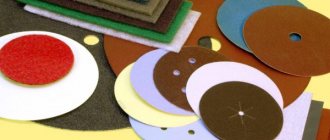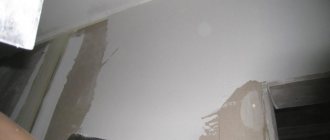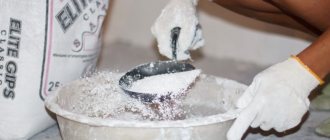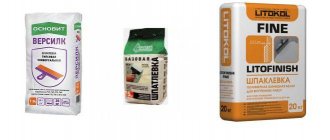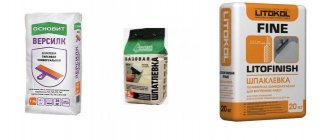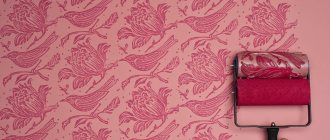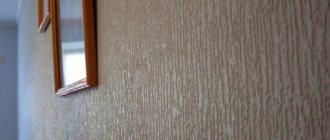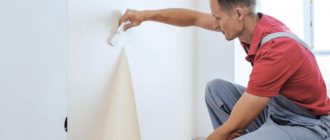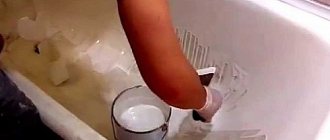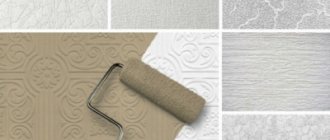When planning to do renovation work, a person quite often thinks about what wallpaper is best to use. Some people prefer to re-glue them as needed or at will, while others use wallpaper intended for painting. The second option allows owners not only to save on material, but also to choose any color scheme and combine several shades. And of course, such a coating will last much longer than conventional wallpaper.
Choosing a roller for painting wallpaper for painting
Painting walls has become popular. However, painting requires careful preparation of the surface, and this affects the costs of material, physical and time. To save money, paintable wallpaper is used to decorate walls, which will smooth out all defects and visually level the surface to be decorated. There is another advantage here - the presence of texture. Only a master can simply paint a wall to make it look perfect. On a smooth surface, drips, uneven coloring and other flaws will inevitably be evident, but on a textured surface the imperfections are not noticeable, and painting wallpaper successfully is not only possible for a professional.
Tinting technique
The modern construction market offers a lot of color variations of paints, but not all factory colors allow homeowners’ design ideas to come to life. In this case, you can purchase classic white wallpaper paint and tint it in the desired tone. There are two methods for this:
1.Hand tinting is a completely simple process. It is enough to purchase the desired pigment and, by increasing the concentration in the coloring composition, achieve the optimal color. The more pigment, the richer the final shade.
Important! After drying on the surface, the shade becomes lighter. To achieve the desired brightness, it is recommended to make the composition 1 shade darker or carry out a series of test tinting on fragments of wallpaper.
2. Computer tinting is a new service that involves digital modeling of the desired shade. The computer will calculate the exact amount of pigment that needs to be added to obtain a particular tone after the walls have dried.
Tinting the coloring composition will allow you to create the optimal shade for the author's design.
Master class on painting wallpaper green:
Instructions for gluing and decorative painting of wallpaper:
Pros and cons of working with a roller
Using a roller to paint any walls has many advantages over classic brush painting:
- coverage of a larger area;
- saving time;
- the ability to replace the roller within a minute depending on the work performed;
- working with various types of surfaces;
- a more even result of applying paint without drips or streaks;
- economical paint consumption;
- the ability to work at heights by extending the handle.
However, there are some disadvantages to this tool:
- the cost of a roller is higher compared to a brush;
- difficulty in processing corners, joints and thin elements;
- the need to frequently replace the fur coat.
However, if you take into account all the features of working with the tool, you can save money and paint everything that needs to be painted.
The range of rollers is quite large: for each operation you can select a tool of a certain type and design of the element being painted.
There are several main types of rollers for painting ceilings and walls:
- Velor. This is the best option for applying oil-based and water-based paints. The pile of the roller coat is short, so there is no chance of it being left on the walls. The application of the layer is uniform and smooth, without streaks.
- Foam rubber. Made from synthetic polyurethane. Such foam rubber models are used for priming, for applying water-dispersion paints and other inactive compounds. Their main advantage is their low cost, easy cleaning and a spare tire included.
- Fur rollers are suitable for working with oil paints and enamels. For their manufacture, sheepskin or fur of artificial origin is used.
- Polyamide - rollers with the longest pile of twisted threads. More often sold in light green color. They are used for treating plasterboard surfaces over putty with water-based paints and enamels.
- Textured models have differences in design. They don't have a fur coat. The roller itself is made of rubber or similar hard materials. A certain pattern is applied to the surface. Such options are necessary for working with wet plaster.
According to their purpose, rollers are divided into:
- façade They are larger in size compared to other models. Suitable for outdoor use;
- frame;
- corner roller is suitable for fine work;
- for wallpaper;
- decorative foam rubber.
Each option is selected for specific tasks, so you cannot purchase one roller for all surfaces.
Why is pile length important?
Length is as important a parameter as width, diameter and type of upholstery. Its choice depends on how smooth the surface will be painted. Long and medium coats are appropriate for working with clearly structured walls.
Short pile cannot properly process a smooth wall. It will leave unpainted areas. To achieve perfect coverage, you will have to press too hard on the tool.
A fur coat with long pile is sometimes used to paint a smooth surface. This helps create a beautiful matte effect, but also increases material consumption, since long upholstery applies a thick layer of paint.
Technology and features of painting various types of wallpaper
Before you begin, you must:
- prepare the room itself and the walls, take out the furniture, cover with masking tape the places where paint may get on (plinths, etc.);
- the paint is applied after the glue has dried completely; you should not open the windows into the room, as they may become deformed or even fall off after painting;
- Some wallpaper requires the application of a primer;
- for convenience, you should use a special paint tray;
- all actions begin from the ceiling to the floor; you can use a brush to paint hard-to-reach places;
- the drawing is painted with a brush;
- the surface after applying the paint and varnish substance should be streak-free; do not hold the roller in one place for a long time; this will help create a layer with the most invisible transitions.
There are some painting features that depend on the type of wallpaper:
- non-woven ones are glued to the wall with the smooth side, and the textured part is painted, although it looks pretty good even without painting. Apply two layers of paint, but do not hold the roller in one place for long, so that the wallpaper does not become too saturated;
- paper, for them they use a material with a special composition, it is also not recommended to apply it until there is an excess; apply a second layer, only if the first one has errors. There should be no glue left on the walls; this may affect the quality of work;
- glass wallpaper is the most durable, the canvas hides all imperfections, the texture does not absorb paint, but allows it to penetrate between the fibers. Due to the fact that the structure of the wallpaper resembles glass wool, it is worth applying the materials to them using protective equipment. This type requires treatment with a primer; the paint itself is applied in two layers, but allowing the first to dry first.
What you need to know before dyeing
- The wallpaper to be painted must dry completely after gluing. This usually takes 2-3 days.
- The first time the coating is painted at least twice. The second layer is applied only after the first has completely dried; the drying time is indicated on the paint packaging and is at least an hour.
- It is recommended to prime fiberglass before painting; this information is indicated in the annotation. Non-woven and paper ones do not require additional processing.
- After pasting non-woven wallpaper, remove all traces of glue, otherwise the paint will lie unevenly.
- Keep in mind that when painting in several layers, the final color will be more saturated. Therefore, it is recommended to make the first layer a little lighter than the next one.
- The paint should have the consistency of liquid sour cream. If necessary, dilute the paint with water or solvent and mix thoroughly until smooth.
- The optimal temperature for painting work is 17-22C.
Having prepared everything you need, get to work.
Roller selection
Once you have decided on the coloring mixtures, you need to choose a roller suitable for the job. Its selection should be done not before buying paint, but after that. Otherwise, it may not fully match the properties of the paint, which can negatively affect the final result of the work.
It is worth noting that the correct choice of roller comes second after paint, since it determines how thinly and evenly the mixture will be distributed over the working surface.
A roller for painting any type of special wallpaper (especially for non-woven and glass wallpaper) must meet the following requirements:
- absorbs paint well;
- Wring it out well (after spinning, the coloring mixture should not flow down the roller);
- have a soft surface (old and hardened rollers with various solutions left on them are not suitable for these purposes, even if they were soaked for a long period of time before use).
In addition, the roller should have a “coat” of short pile made of faux fur.
It is best if the roller you use to paint non-woven wallpaper is new. Thus, the paint layer on the working surface will be uniform and thin, as required by existing painting technology.
The roller that is optimally suited for this type of work can be of the following types:
- roller nozzle with a length of up to 25 cm - allows for uniform application of the layer without creating visible transitions;
- a roller nozzle with a short length (no more than 10 cm) - allows you to effectively paint hard-to-reach places.
It's best if you have both options on hand.
Please note that if you prime the surface of the wallpaper before painting, then you need to buy one spare roller. The paint will adhere better to a primed base.
How long after pasting can wallpaper be painted?
To ensure that the paint adheres well and does not cause stains, it is necessary to use only a properly prepared surface.
After gluing, the canvases must dry thoroughly. After that, the quality of gluing the joints is checked and only then paint is applied.
In order for the wallpaper to dry quickly, it is necessary to create good conditions in the apartment. The room should be warm and free from draft.
Not all wallpaper can be painted
Roller size
Rollers for painting walls are divided into different types. One of the parameters of their classification is size. This takes into account the diameter and width of the nozzle. Depending on this, rollers are divided into:
- Midi. The nozzle has a width of up to 20 cm and a diameter of up to 9 cm. Such paint rollers are considered universal and the best for finishing walls at home. They are light in weight and highly productive.
- Mini. The width of the tool does not exceed 15 cm. They are mainly used for finishing small areas and hard-to-reach places.
- Maxi. These rollers are also called façade rollers. This is due to the fact that they have large attachments, the width of which exceeds 25 cm and the diameter is 8 cm. The roller is a professional tool, as it is equipped with a high-quality coat and a durable rod, which allows for large-scale work.
To quickly carry out finishing work, many opt for the latest type of tool. But, in fact, this is not the best choice for indoor work. The fact is that the façade finishing roller absorbs a lot of paint. As a result, it becomes heavy, which makes the work somewhat more difficult. It is better to choose a medium-sized tool that has high technical characteristics.
Certain types of wall rollers are used to perform certain jobs. This is worth considering when choosing them. So, if we are talking about painting the outside of the house, then it is better to opt for facade rollers. The peculiarity of the model is that the nozzle makes few revolutions due to its large diameter. This prevents splashing of the paint and varnish substance during the finishing process. Framing tools are used to cover uneven surfaces.
Paint selection
Non-woven wallpaper (smooth or textured Wellton) is one of the types of material that can be painted multiple times after gluing. But in order for any further layer to turn out well, and for the texture of the wallpaper rolls not to undergo too visible changes, it is necessary to choose the right paint.
The success of this type of finishing depends on the following factors:
- Good choice of cladding (textured or smooth materials from Wellton or any other manufacturer). It is necessary to pay attention to the fact that it is better to select textured types for painting, since when painting the ceiling or walls they acquire a more magnificent appearance than if laminated wallpaper was used.
- Correctly executed gluing technique.
- Good selection of paint and roller.
The quality of the final result directly depends on all such parameters. In this case, a special role in the success of paint coating is given to the correct choice of paint. You need to choose it before buying a roller.
It is necessary to pay attention that all materials, and also tools (roller, brushes, etc.) should be purchased at the same time, so that sellers can visually evaluate the type of wallpaper rolls, paint or roller and choose the most suitable tools and materials for each other. .
Non-woven wallpaper is currently an excellent option for repeated wall and ceiling painting. Thanks to this, the question “what type of paint is suitable for non-woven wallpaper” is considered very pressing. Many with a similar question turn to trade managers at markets and points of sale. But in order to actually acquire what you need, you need to know certain subtleties. For example, non-woven wallpaper (Wellton brand, etc.) can only be painted with water-dispersion based paint. In this case, it can be divided into the following categories:
- latex;
- acrylic;
- water-based.
All three of these options are quite applicable for the base that will be formed by non-woven wallpaper. Because of this, you need to be very careful not to purchase another option, which will ultimately lead to final damage to the wall finish or flow.
In this situation, you can use an ordinary water-based emulsion, which can be given any color using a variety of colors by self- or professional tinting. But here, do not forget that colors do not have to contain harmful elements and solvents. Therefore, before purchasing them, it is necessary to become familiar with the composition, information about which is printed on the packaging.
It is much better to use water-based acrylic compositions for painting non-woven wallpaper (for example, Wellton brand). They have a large selection, and you can easily find the best option for yourself.
This life-saving construction tool for some
If we are talking about working with wallpaper, then the roller certainly has an advantage
But the main merit of rollers is not even the work that they help to do.
Advantages
Our love for rollers lies in their reciprocity. This often happens - our love arises for someone as a response to love for us. Same with the roller.
- it is very convenient to work with it - you apply paint on one side or dip the entire tool into the paint, roll it out in the tray to evenly distribute the material over the entire cylindrical plane of the roller and forward, transfer the paint, varnish or glue to the work surface - this simple method of painting made me many believe in themselves and become real painters;
If everything is done correctly, then whether it’s a roller for wallpaper joints or a roller for painting wallpaper, you can’t do without a bath
This is when rollers come in handy - when working on the ceiling with your own hands
There are also disadvantages
However, in this love there are also obstacles that must always be kept in mind. Rollers will not always help us.
Among these special cases:
- work on internal corners, when there is a high probability that, while finishing one wall, you will definitely climb onto the adjacent one, so here it is better to treat 5-10 cm from the corner with a brush;
- work on glass wallpaper and other types of embossed wallpaper; the fact is that in these cases you need to work only with rollers with soft nozzles and very finely control the degree of pressure on the surface; if you are not confident in your professionalism, it is better to use rags and a more sensitive tool such as your hands in this situation;
- the great extravagance of this love of ours (and why be surprised, although the roller is masculine); Indeed, if you have suspicions that there may not be enough paint, then it is better to work with a brush; with a roller it will be more difficult to control the consumption;
- the impossibility of working on potholes, crevices and joints - but this is understandable, no matter how small the roller we take, it will not be the size of a Kinder Surprise; brushes are best for joints;
The attachment on the roller when painting can be anything, here a lot depends on the imagination of the master
- the roller is some kind of mechanism with its own character (and in love how could it be otherwise!), so it must be very precisely adjusted; debugging consists in keeping the mechanism clean so that rotation occurs evenly and does not jam; In addition, the roller must be very accurately centered along the axis of the inner rod, otherwise the paint will be applied in streaks, and this is a real disaster when working.
- There are also a few very specific situations where a roller will only ruin everything; for example, you are strengthening a joint between sheets of drywall:
- first prime the joint itself;
- then, without waiting for the primer to dry completely, apply mounting reinforced paper tape or mesh onto it;
- but it is better to press it along its entire length manually or gently with a spatula; if you run a roller along the tape, it will stick to it and move away after it; you will have to wait until the primer dries more or use your hands; it is better to choose the latter.
Before performing work, the instructions advise stocking up on several attachments at once.
Helpful advice! When we talk about rollers, we don’t even mean a handle with a shaft attached to rollers. First of all, all the fuss is contained in a nozzle that can be changed. The success of the work largely depends on the quality of the nozzle, its reliable fastening and cleanliness. Therefore, before starting work, we advise you to stock up not only with several rollers, but also for each with several attachments with piles of different lengths. True, in this situation you will certainly have to solve these issues of choosing which roller to paint the wallpaper for painting or which roller is better for gluing wallpaper or, in other words, what rollers are needed for gluing wallpaper.
Roller selection criteria
In addition to the type of material, there are several other criteria that allow you to choose a roller for water-based paint for ceilings and walls.
Tool dimensions
The overall speed of operation depends on the width of the ink drum. When choosing which roller to paint the walls and ceiling with water-based paint, be sure to take into account the total volume of the surface and its architectural features - the presence of cornices, cracks, difficult corners or joints. Modern models can be divided into three groups:
- Short mini-rollers - the width of the coating is about ten, and the radius of the drum is about one and a half centimeters. Such models are optimal for processing difficult areas that cannot be painted over with larger tools.
- Standard rollers are up to 18 centimeters wide and 6 centimeters in diameter. A standard model suitable for working with any flat surfaces.
- Large rollers are suitable for professional work, since, despite the quick surface treatment, they require special skills and preparation for use.
Type of surface to be painted
When choosing which roller to paint walls, ceilings or wallpaper with water-based paint for painting, you must also take into account the specific features of the object of work.
1) For painting walls and ceilings with water-based emulsion that have natural defects or are covered with special relief plaster or wallpaper, it is better to choose a roller with an elongated fleecy coating. It provides high-quality painting of all grooves, recesses and patterns.
2) For smooth and even walls, rollers with a short coat are optimal - they allow you to apply the composition efficiently and prevent the formation of drips or streaks.
3) To process ceilings that require increased smoothness of the coating, you should choose tools with a soft texture of medium length. It is also important to consider the length of the handle to ensure a comfortable workflow.
Tool quality
Another important stage is checking the quality of the proposed model. There are several simple ways to do this.
1) Assessing the quality of seams. The surface of the roller “coat” must be even and smooth, otherwise during painting the seam will significantly affect the texture being formed, leaving noticeable marks.
2) Fleecy rollers should be tested for quality of stitching. It is enough to try to pinch off a small amount of the coating: if the fibers remain in your hand, then the same fate awaits your walls.
3) Check availability of replacement drums. Such models, as a rule, are more expensive, but they allow you to quickly and efficiently change a “coat” clogged with paint for a new one, without stopping the work process.
4) Try on how the roller handle will fit in your palm. This is an important factor - painting work lasts several hours, and discomfort from the tool can affect the final result.
That's all. Now you know how to choose a roller for water-based paint. Good luck!
